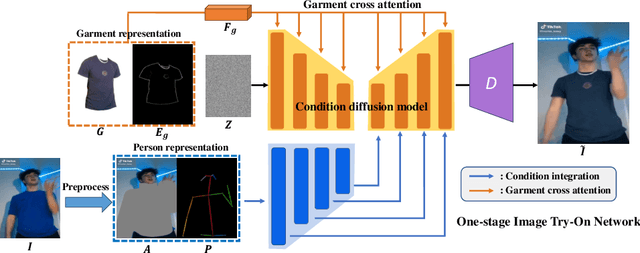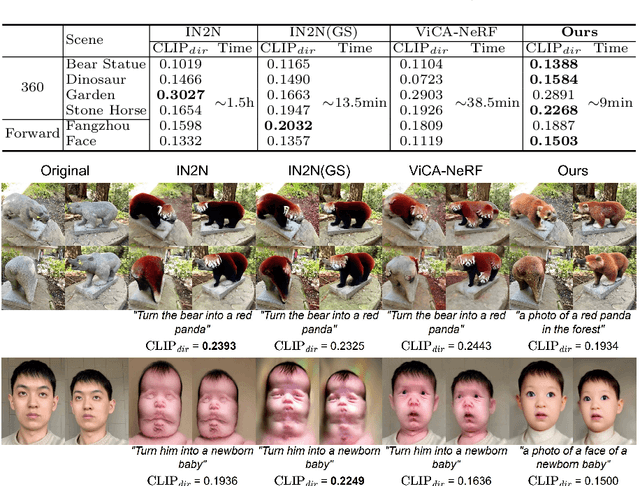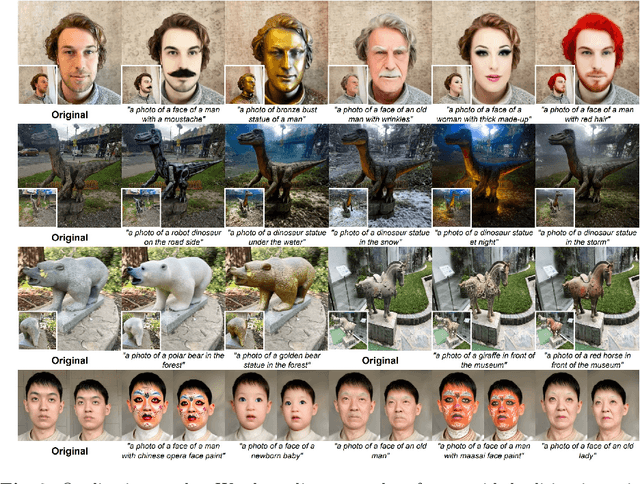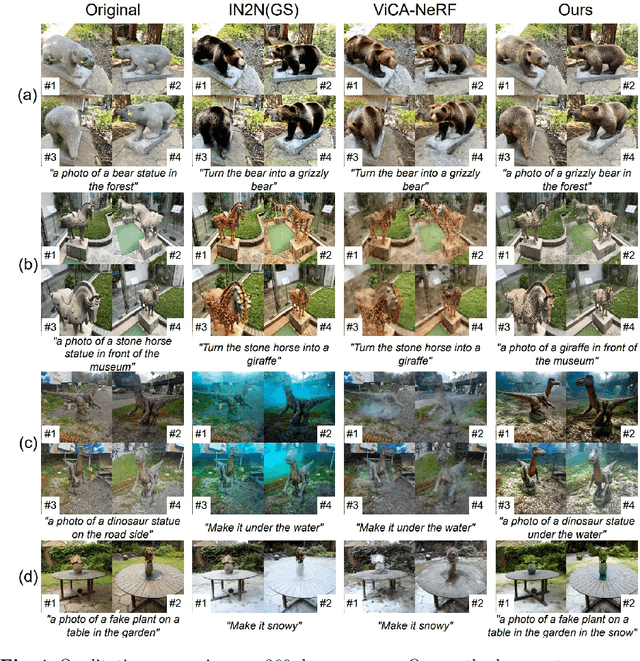Guangrun Wang
UML-CoT: Structured Reasoning and Planning with Unified Modeling Language for Robotic Room Cleaning
Sep 26, 2025Abstract:Chain-of-Thought (CoT) prompting improves reasoning in large language models (LLMs), but its reliance on unstructured text limits interpretability and executability in embodied tasks. Prior work has explored structured CoTs using scene or logic graphs, yet these remain fundamentally limited: they model only low-order relations, lack constructs like inheritance or behavioral abstraction, and provide no standardized semantics for sequential or conditional planning. We propose UML-CoT, a structured reasoning and planning framework that leverages Unified Modeling Language (UML) to generate symbolic CoTs and executable action plans. UML class diagrams capture compositional object semantics, while activity diagrams model procedural control flow. Our three-stage training pipeline combines supervised fine-tuning with Group Relative Policy Optimization (GRPO), including reward learning from answer-only data. We evaluate UML-CoT on MRoom-30k, a new benchmark of cluttered room-cleaning scenarios. UML-CoT outperforms unstructured CoTs in interpretability, planning coherence, and execution success, highlighting UML as a more expressive and actionable structured reasoning formalism.
GS: Generative Segmentation via Label Diffusion
Aug 27, 2025Abstract:Language-driven image segmentation is a fundamental task in vision-language understanding, requiring models to segment regions of an image corresponding to natural language expressions. Traditional methods approach this as a discriminative problem, assigning each pixel to foreground or background based on semantic alignment. Recently, diffusion models have been introduced to this domain, but existing approaches remain image-centric: they either (i) use image diffusion models as visual feature extractors, (ii) synthesize segmentation data via image generation to train discriminative models, or (iii) perform diffusion inversion to extract attention cues from pre-trained image diffusion models-thereby treating segmentation as an auxiliary process. In this paper, we propose GS (Generative Segmentation), a novel framework that formulates segmentation itself as a generative task via label diffusion. Instead of generating images conditioned on label maps and text, GS reverses the generative process: it directly generates segmentation masks from noise, conditioned on both the input image and the accompanying language description. This paradigm makes label generation the primary modeling target, enabling end-to-end training with explicit control over spatial and semantic fidelity. To demonstrate the effectiveness of our approach, we evaluate GS on Panoptic Narrative Grounding (PNG), a representative and challenging benchmark for multimodal segmentation that requires panoptic-level reasoning guided by narrative captions. Experimental results show that GS significantly outperforms existing discriminative and diffusion-based methods, setting a new state-of-the-art for language-driven segmentation.
ReaLM: Reflection-Enhanced Autonomous Reasoning with Small Language Models
Aug 17, 2025Abstract:Small Language Models (SLMs) are a cost-effective alternative to Large Language Models (LLMs), but often struggle with complex reasoning due to their limited capacity and a tendency to produce mistakes or inconsistent answers during multi-step reasoning. Existing efforts have improved SLM performance, but typically at the cost of one or more of three key aspects: (1) reasoning capability, due to biased supervision that filters out negative reasoning paths and limits learning from errors; (2) autonomy, due to over-reliance on externally generated reasoning signals; and (3) generalization, which suffers when models overfit to teacher-specific patterns. In this paper, we introduce ReaLM, a reinforcement learning framework for robust and self-sufficient reasoning in vertical domains. To enhance reasoning capability, we propose Multi-Route Process Verification (MRPV), which contrasts both positive and negative reasoning paths to extract decisive patterns. To reduce reliance on external guidance and improve autonomy, we introduce Enabling Autonomy via Asymptotic Induction (EAAI), a training strategy that gradually fades external signals. To improve generalization, we apply guided chain-of-thought distillation to encode domain-specific rules and expert knowledge into SLM parameters, making them part of what the model has learned. Extensive experiments on both vertical and general reasoning tasks demonstrate that ReaLM significantly improves SLM performance across aspects (1)-(3) above.
One Model For All: Partial Diffusion for Unified Try-On and Try-Off in Any Pose
Aug 06, 2025Abstract:Recent diffusion-based approaches have made significant advances in image-based virtual try-on, enabling more realistic and end-to-end garment synthesis. However, most existing methods remain constrained by their reliance on exhibition garments and segmentation masks, as well as their limited ability to handle flexible pose variations. These limitations reduce their practicality in real-world scenarios-for instance, users cannot easily transfer garments worn by one person onto another, and the generated try-on results are typically restricted to the same pose as the reference image. In this paper, we introduce \textbf{OMFA} (\emph{One Model For All}), a unified diffusion framework for both virtual try-on and try-off that operates without the need for exhibition garments and supports arbitrary poses. For example, OMFA enables removing garments from a source person (try-off) and transferring them onto a target person (try-on), while also allowing the generated target to appear in novel poses-even without access to multi-pose images of that person. OMFA is built upon a novel \emph{partial diffusion} strategy that selectively applies noise and denoising to individual components of the joint input-such as the garment, the person image, or the face-enabling dynamic subtask control and efficient bidirectional garment-person transformation. The framework is entirely mask-free and requires only a single portrait and a target pose as input, making it well-suited for real-world applications. Additionally, by leveraging SMPL-X-based pose conditioning, OMFA supports multi-view and arbitrary-pose try-on from just one image. Extensive experiments demonstrate that OMFA achieves state-of-the-art results on both try-on and try-off tasks, providing a practical and generalizable solution for virtual garment synthesis. The project page is here: https://onemodelforall.github.io/.
SIRI-Bench: Challenging VLMs' Spatial Intelligence through Complex Reasoning Tasks
Jun 17, 2025Abstract:Large Language Models (LLMs) are experiencing rapid advancements in complex reasoning, exhibiting remarkable generalization in mathematics and programming. In contrast, while spatial intelligence is fundamental for Vision-Language Models (VLMs) in real-world interaction, the systematic evaluation of their complex reasoning ability within spatial contexts remains underexplored. To bridge this gap, we introduce SIRI-Bench, a benchmark designed to evaluate VLMs' spatial intelligence through video-based reasoning tasks. SIRI-Bench comprises nearly 1K video-question-answer triplets, where each problem is embedded in a realistic 3D scene and captured by video. By carefully designing questions and corresponding 3D scenes, our benchmark ensures that solving the questions requires both spatial comprehension for extracting information and high-level reasoning for deriving solutions, making it a challenging benchmark for evaluating VLMs. To facilitate large-scale data synthesis, we develop an Automatic Scene Creation Engine. This engine, leveraging multiple specialized LLM agents, can generate realistic 3D scenes from abstract math problems, ensuring faithfulness to the original descriptions. Experimental results reveal that state-of-the-art VLMs struggle significantly on SIRI-Bench, underscoring the challenge of spatial reasoning. We hope that our study will bring researchers' attention to spatially grounded reasoning and advance VLMs in visual problem-solving.
Implicit Neural Representations for Chemical Reaction Paths
Feb 20, 2025Abstract:We show that neural networks can be optimized to represent minimum energy paths as continuous functions, offering a flexible alternative to discrete path-search methods like Nudged Elastic Band (NEB). Our approach parameterizes reaction paths with a network trained on a loss function that discards tangential energy gradients and enables instant estimation of the transition state. We first validate the method on two-dimensional potentials and then demonstrate its advantages over NEB on challenging atomistic systems where (i) poor initial guesses yield unphysical paths, (ii) multiple competing paths exist, or (iii) the reaction follows a complex multi-step mechanism. Results highlight the versatility of the method -- for instance, a simple adjustment to the sampling strategy during optimization can help escape local-minimum solutions. Finally, in a low-dimensional setting, we demonstrate that a single neural network can learn from existing paths and generalize to unseen systems, showing promise for a universal reaction path representation.
Making Large Language Models Better Planners with Reasoning-Decision Alignment
Aug 25, 2024Abstract:Data-driven approaches for autonomous driving (AD) have been widely adopted in the past decade but are confronted with dataset bias and uninterpretability. Inspired by the knowledge-driven nature of human driving, recent approaches explore the potential of large language models (LLMs) to improve understanding and decision-making in traffic scenarios. They find that the pretrain-finetune paradigm of LLMs on downstream data with the Chain-of-Thought (CoT) reasoning process can enhance explainability and scene understanding. However, such a popular strategy proves to suffer from the notorious problems of misalignment between the crafted CoTs against the consequent decision-making, which remains untouched by previous LLM-based AD methods. To address this problem, we motivate an end-to-end decision-making model based on multimodality-augmented LLM, which simultaneously executes CoT reasoning and carries out planning results. Furthermore, we propose a reasoning-decision alignment constraint between the paired CoTs and planning results, imposing the correspondence between reasoning and decision-making. Moreover, we redesign the CoTs to enable the model to comprehend complex scenarios and enhance decision-making performance. We dub our proposed large language planners with reasoning-decision alignment as RDA-Driver. Experimental evaluations on the nuScenes and DriveLM-nuScenes benchmarks demonstrate the effectiveness of our RDA-Driver in enhancing the performance of end-to-end AD systems. Specifically, our RDA-Driver achieves state-of-the-art planning performance on the nuScenes dataset with 0.80 L2 error and 0.32 collision rate, and also achieves leading results on challenging DriveLM-nuScenes benchmarks with 0.82 L2 error and 0.38 collision rate.
WildVidFit: Video Virtual Try-On in the Wild via Image-Based Controlled Diffusion Models
Jul 15, 2024



Abstract:Video virtual try-on aims to generate realistic sequences that maintain garment identity and adapt to a person's pose and body shape in source videos. Traditional image-based methods, relying on warping and blending, struggle with complex human movements and occlusions, limiting their effectiveness in video try-on applications. Moreover, video-based models require extensive, high-quality data and substantial computational resources. To tackle these issues, we reconceptualize video try-on as a process of generating videos conditioned on garment descriptions and human motion. Our solution, WildVidFit, employs image-based controlled diffusion models for a streamlined, one-stage approach. This model, conditioned on specific garments and individuals, is trained on still images rather than videos. It leverages diffusion guidance from pre-trained models including a video masked autoencoder for segment smoothness improvement and a self-supervised model for feature alignment of adjacent frame in the latent space. This integration markedly boosts the model's ability to maintain temporal coherence, enabling more effective video try-on within an image-based framework. Our experiments on the VITON-HD and DressCode datasets, along with tests on the VVT and TikTok datasets, demonstrate WildVidFit's capability to generate fluid and coherent videos. The project page website is at wildvidfit-project.github.io.
AnimateZoo: Zero-shot Video Generation of Cross-Species Animation via Subject Alignment
Apr 07, 2024Abstract:Recent video editing advancements rely on accurate pose sequences to animate subjects. However, these efforts are not suitable for cross-species animation due to pose misalignment between species (for example, the poses of a cat differs greatly from that of a pig due to differences in body structure). In this paper, we present AnimateZoo, a zero-shot diffusion-based video generator to address this challenging cross-species animation issue, aiming to accurately produce animal animations while preserving the background. The key technique used in our AnimateZoo is subject alignment, which includes two steps. First, we improve appearance feature extraction by integrating a Laplacian detail booster and a prompt-tuning identity extractor. These components are specifically designed to capture essential appearance information, including identity and fine details. Second, we align shape features and address conflicts from differing subjects by introducing a scale-information remover. This ensures accurate cross-species animation. Moreover, we introduce two high-quality animal video datasets featuring a wide variety of species. Trained on these extensive datasets, our model is capable of generating videos characterized by accurate movements, consistent appearance, and high-fidelity frames, without the need for the pre-inference fine-tuning that prior arts required. Extensive experiments showcase the outstanding performance of our method in cross-species action following tasks, demonstrating exceptional shape adaptation capability. The project page is available at https://justinxu0.github.io/AnimateZoo/.
GaussCtrl: Multi-View Consistent Text-Driven 3D Gaussian Splatting Editing
Mar 14, 2024



Abstract:We propose GaussCtrl, a text-driven method to edit a 3D scene reconstructed by the 3D Gaussian Splatting (3DGS). Our method first renders a collection of images by using the 3DGS and edits them by using a pre-trained 2D diffusion model (ControlNet) based on the input prompt, which is then used to optimise the 3D model. Our key contribution is multi-view consistent editing, which enables editing all images together instead of iteratively editing one image while updating the 3D model as in previous works. It leads to faster editing as well as higher visual quality. This is achieved by the two terms: (a) depth-conditioned editing that enforces geometric consistency across multi-view images by leveraging naturally consistent depth maps. (b) attention-based latent code alignment that unifies the appearance of edited images by conditioning their editing to several reference views through self and cross-view attention between images' latent representations. Experiments demonstrate that our method achieves faster editing and better visual results than previous state-of-the-art methods.
 Add to Chrome
Add to Chrome Add to Firefox
Add to Firefox Add to Edge
Add to Edge